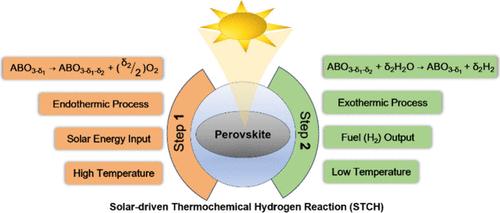Perovskite Oxide Materials for Solar Thermochemical Hydrogen Production from Water Splitting through Chemical Looping
IF 11.3
1区 化学
Q1 CHEMISTRY, PHYSICAL
引用次数: 0
Abstract
Solar-driven thermochemical hydrogen (STCH) production represents a sustainable approach for converting solar energy into hydrogen (H2) as a clean fuel. This technology serves as a crucial feedstock for synthetic fuel production, aligning with the principles of sustainable energy. The efficiency of the conversion process relies on the meticulous tuning of the properties of active materials, mostly commonly perovskite and fluorite oxides. This Review conducts a comprehensive review encompassing experimental, computational, and thermodynamic and kinetic property studies, primarily assessing the utilization of perovskite oxides in two-step thermochemical reactions and identifying essential attributes for future research endeavors. Furthermore, this Review delves into the application of machine learning (ML) and density functional theory (DFT) for predicting and classifying the thermochemical properties of perovskite materials. Through the integration of experimental investigations, computational modeling, and ML methodologies, this Review aspires to expedite the screening and optimization of perovskite oxides, thus enhancing the efficiency of STCH processes. The overarching objective is to propel the advancement and practical integration of STCH systems, contributing significantly to the realization of a sustainable and carbon-neutral energy landscape.

通过化学循环利用水裂解制取太阳能热化学氢的过氧化物材料
太阳能驱动热化学制氢(STCH)是将太阳能转化为氢气(H2)这种清洁燃料的一种可持续方法。该技术是合成燃料生产的重要原料,符合可持续能源原则。转换过程的效率取决于对活性材料(通常是过氧化物和萤石氧化物)特性的精心调整。本综述对实验、计算、热力学和动力学特性研究进行了全面综述,主要评估了在两步热化学反应中利用包晶石氧化物的情况,并确定了未来研究工作的基本属性。此外,本综述还深入探讨了机器学习(ML)和密度泛函理论(DFT)在预测和分类包晶材料热化学性质方面的应用。通过整合实验研究、计算建模和 ML 方法,本综述希望加快筛选和优化包晶氧化物,从而提高 STCH 过程的效率。本综述的总体目标是推动 STCH 系统的发展和实际集成,为实现可持续和碳中性能源格局做出重大贡献。
本文章由计算机程序翻译,如有差异,请以英文原文为准。
求助全文
约1分钟内获得全文
求助全文
来源期刊

ACS Catalysis
CHEMISTRY, PHYSICAL-
CiteScore
20.80
自引率
6.20%
发文量
1253
审稿时长
1.5 months
期刊介绍:
ACS Catalysis is an esteemed journal that publishes original research in the fields of heterogeneous catalysis, molecular catalysis, and biocatalysis. It offers broad coverage across diverse areas such as life sciences, organometallics and synthesis, photochemistry and electrochemistry, drug discovery and synthesis, materials science, environmental protection, polymer discovery and synthesis, and energy and fuels.
The scope of the journal is to showcase innovative work in various aspects of catalysis. This includes new reactions and novel synthetic approaches utilizing known catalysts, the discovery or modification of new catalysts, elucidation of catalytic mechanisms through cutting-edge investigations, practical enhancements of existing processes, as well as conceptual advances in the field. Contributions to ACS Catalysis can encompass both experimental and theoretical research focused on catalytic molecules, macromolecules, and materials that exhibit catalytic turnover.
 求助内容:
求助内容: 应助结果提醒方式:
应助结果提醒方式:


